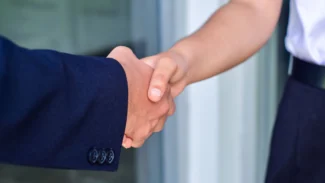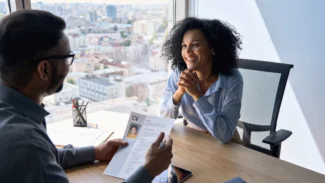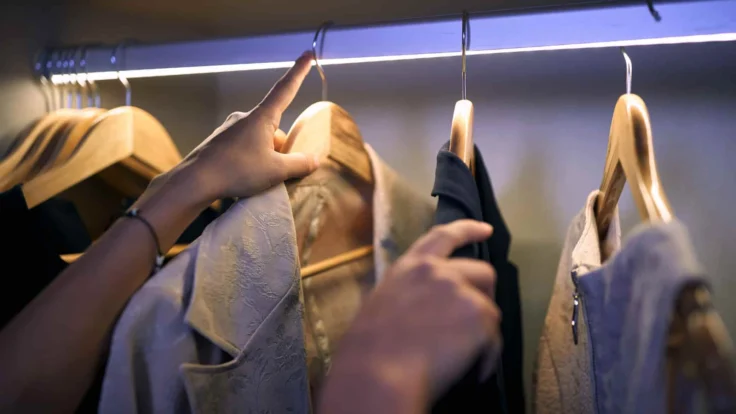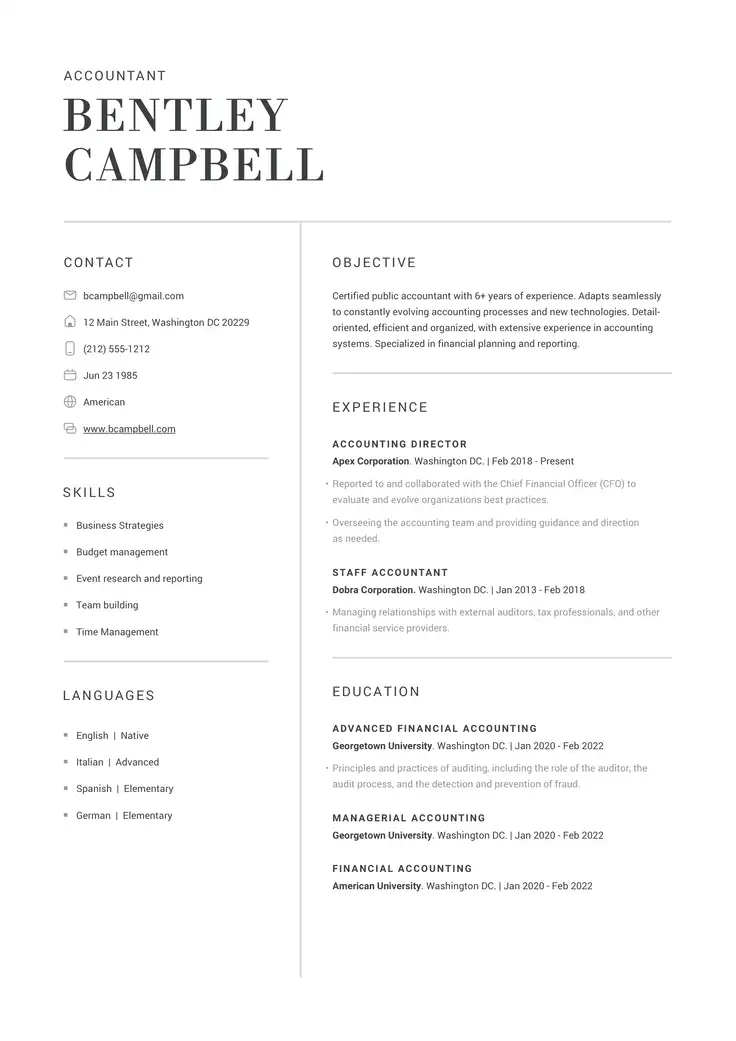- Why Your Outfit Is Important for an Interview
- Job Interview Dress Codes
- How To Dress for an Interview by Industry
- What Should Women Wear to an Interview
- What Should Men Wear to an Interview
- What Not To Wear to an Interview
- What To Wear to a Virtual Interview
- Best Hairstyles for an Interview
- What To Wear to an Internship Interview
- Job Interview Attire Frequently Asked Questions
You’ve probably heard the phrase, “you never get a second chance to make a first impression,” and nowhere is this truer than in a job interview. Before you even say a word, your interview attire communicates volumes about your professionalism, confidence, and how well you’ll fit into the company’s culture.
In fact, research shows that it takes less than seven seconds for someone to form an impression of you. That means your outfit choice plays a key role in how a hiring manager perceives your judgment, attention to detail, and readiness for the role.
There is good news! Dressing for success doesn’t have to be stressful. Whether you’re preparing for an in-person meeting or a virtual interview, in this article, you’ll learn what you should wear to interviews, as well as what not to wear. We’ll go over:
- Dress codes: Business formal vs. business casual vs. casual, with ideas for job interview outfits for women and men.
- What not to wear: Clear rules on jeans, sweaters, hoodies, sandals, and flashy styles.
- Virtual interviews: Camera-friendly colors, full outfit reminders, and background tips.
- Extras: Seasonal outfit advice (summer vs. winter), and a quick checklist of what to bring.
The right outfit doesn’t just make you look prepared, it helps you feel prepared. When your appearance matches your ambition, you send a clear message that you’re confident, capable, and ready for the job.
But first, you need to get there. Use our AI resume builder to create a comprehensive resume in just a few minutes.
Why Your Outfit Is Important for an Interview
When you’re looking for interview advice, never ignore fashion tips.
Think of your outfit as your visual resume. Your appearance is one of the first things that interviewers notice. It tells your potential employer whether you take the opportunity seriously, understand the company’s culture, and can adapt to their work environment.
So it’s important to dress in a way that makes you look professional and like you belong in an office.
As for what counts as “professional,” this depends on the industry and company you’re applying to, but there are some general guidelines that apply everywhere.
Either way, dressing appropriately demonstrates good judgment and an ability to align with expectations, two traits every employer values.
What to wear to an interview
The attire you decide on for your interview should be consistent with the company culture.
A hiring manager can tell if you have a feel for their company or not immediately because of the clothes you wear to the interview.
Doing some research ahead of time can help you determine what kind of clothes are appropriate for the company you’ll be interviewing with. You can check out their “About Us” section on their website for some ideas.
-
💡 Our expert’s advice

A good rule of thumb is to always dress one level above the company’s typical office dress code. For example, if a company says it has a casual environment, aim for business casual attire: dress pants or khakis, a button-down shirt, and dress shoes. If it’s a corporate environment or a field like finance or law, a formal business outfit such as a full suit or skirt suit is the safe choice.
Job Interview Dress Codes
After you research the company, you should have an idea of its culture and office dress code, whether casual, business casual, or more formal. Here are some examples of job interview attire for each of these codes, with examples to help you strike the right balance between a professional appearance and personal comfort.
Casual outfits for an interview
If you’re interviewing at a casual company, like a creative agency, small startup, or tech company, stick with the same vibe. You’ll still want to look neat, approachable, and well-prepared.
For men, a button-down or polo shirt and dark jeans (non-ripped) are fine, but that doesn’t mean you can just wear anything. Wearing a watch or a leather belt would also add a nice touch.
Avoid shorts, tank tops, hoodies, and flip-flops. Even in a laid-back setting, these choices can look too informal. You want to be casual, not dressed for the beach.
For women, dark denim or tailored pants paired with a blouse and jewelry that isn’t over-the-top would be great. You also don’t need to wear high heels in this scenario.
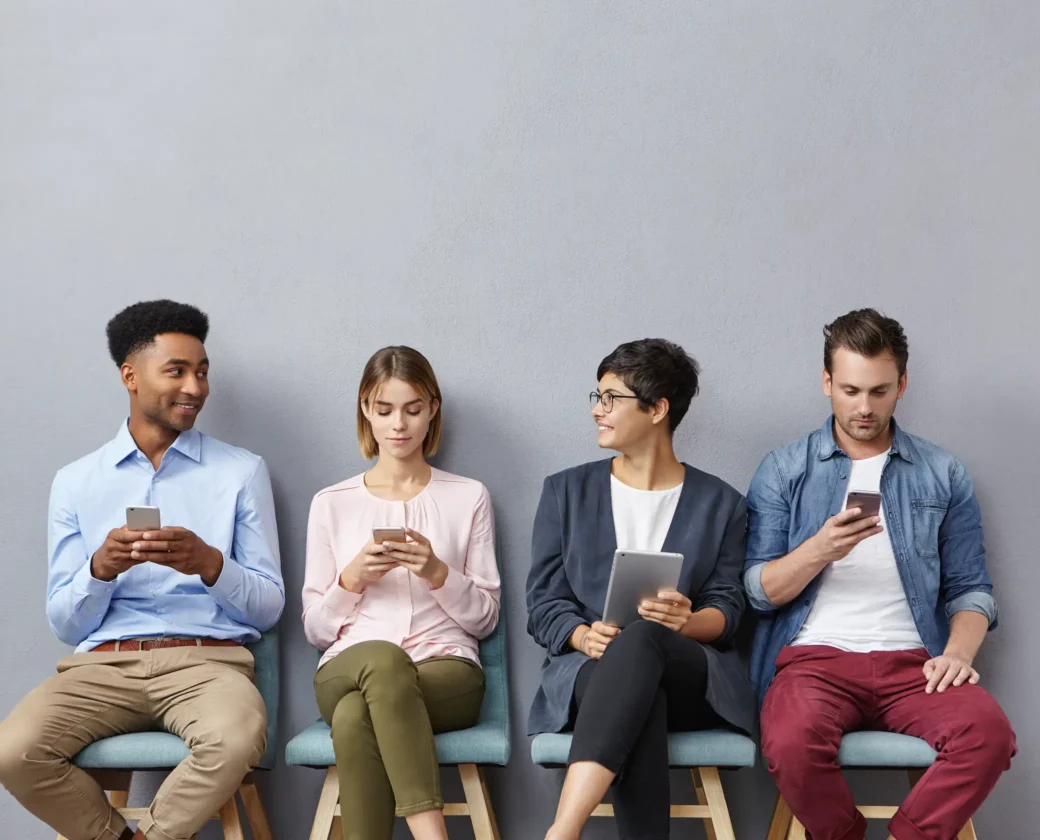
💡Tip
If you want to show a touch of personal style, add a simple accessory or choose a solid color that complements your skin tone.
Business casual outfits for an interview
Business casual is one of the most common dress codes today, especially in tech start-ups, education, and creative industries. It’s a good balance between comfort and professionalism, showing that you can be taken seriously while still being approachable.
For women, you can wear loafers or heels (comfortable ones), and a blouse with trousers or a skirt, or a conservative wrap dress would create a great business casual combination. According to the University of Illinois Career Center, skirts should sit at knee-level or below. A button-down shirt is a great choice as well.
For men specifically, you’ll want to wear a collared button-down shirt (a tie isn’t necessary). You could consider wearing a colored shirt, so you stick out from the other applicants. Avoid wearing jeans or sneakers. Wear khakis, and if it’s cold, you can add a sweater over the shirt.
Again, this can vary from place to place, so make sure to know what to expect.
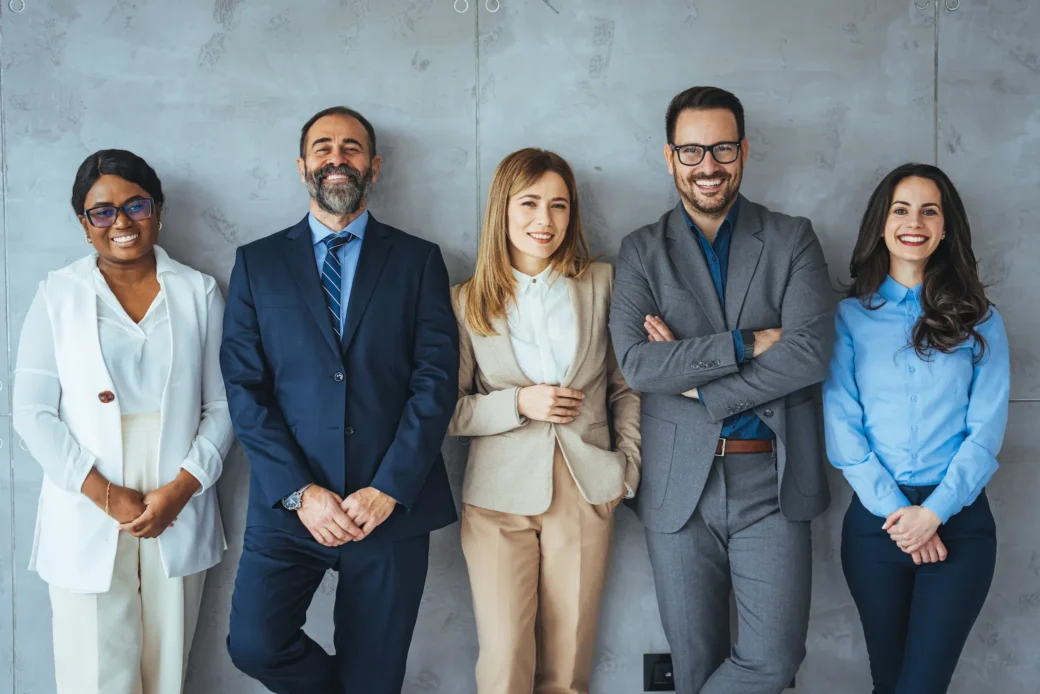
💡Tip
Business casual gives you flexibility, but looking neat and well-put-together is key. Clothes should always be clean, well-fitted, and in good condition.
Business professional outfits for an interview
If you’re applying to corporate roles, financial institutions, or management positions, formal professional attire is the safest choice.
For men, this usually means a full suit with a matching jacket and trousers, a plain dress shirt, and a tie. Stick to dark colors like navy, black, or gray, and pair them with polished dress shoes.
For women, tailored suits with either trousers or a skirt and blazer are ideal. A classic dress in a neutral color, paired with pantyhose and closed-toe pumps, is also appropriate.
Accessories should be simple and understated, and makeup and hairstyles should be neat and conservative.
This level of dress shows you take the interview seriously and understand the expectations of a professional setting.
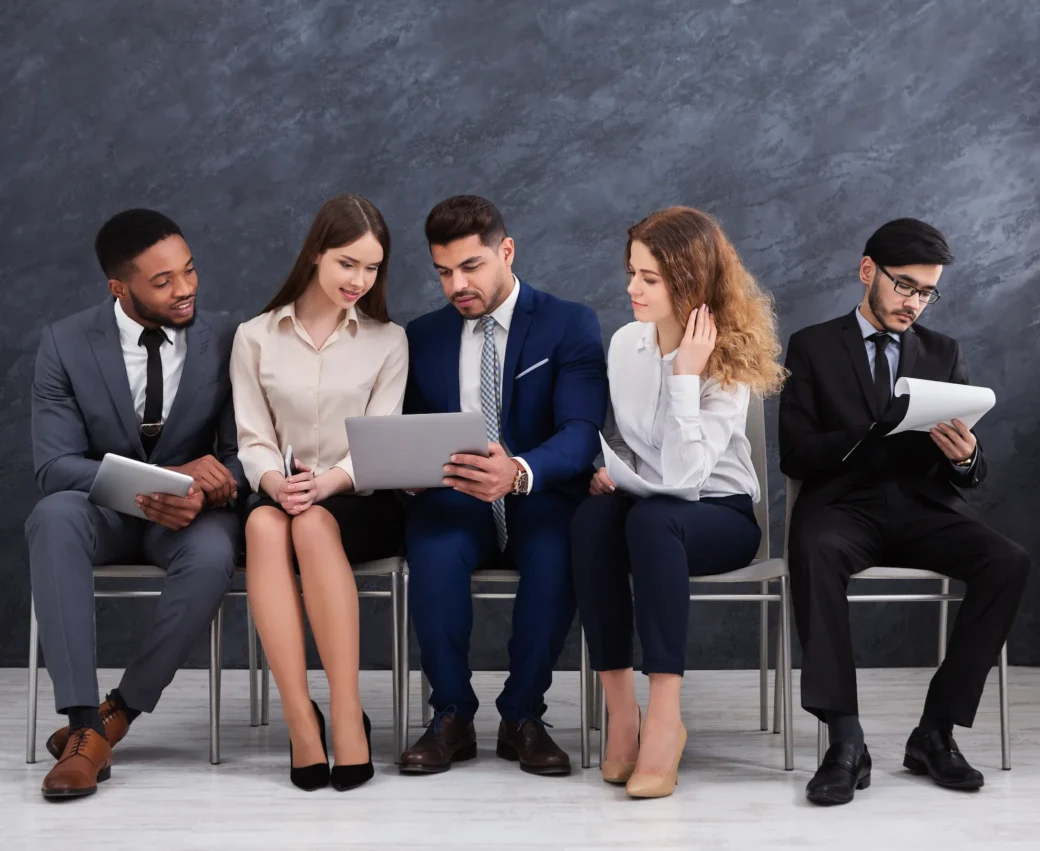
What to wear when there’s no dress code
Sometimes a job posting or recruiter doesn’t mention an office dress code, leaving you wondering how formal you need to be. In this case, it’s always best to err on the side of caution and choose business professional attire.
When in this situation, you want to look good, like you the clothes you are wearing were made especially for you.
Women should wear dress pants or a skirt along with a jacket. You can try to be a bit creative with that combination, as well as with some unique colors.
Men won’t have the option of wearing unique colors with this one, but a simple suit-and-tie combination is almost always appropriate for a job interview.
How To Dress for an Interview by Industry
What you wear should reflect the expectations of the field you’re entering. A suit and tie may be essential in finance or law, but could feel out of place in a creative startup. Here are some quick pointers:
| Industry | Recommended attire |
|---|---|
| Finance, law, consulting | Stick to business professional. Dark suits, dress shirts, solid colors, polished shoes, and conservative accessories signal professionalism and trust. |
| Tech & startups | Lean towards business casual attire. A blazer with chinos or a blouse with trousers works well. This look is polished but not stiff. Some companies value individuality, so a pop of color or stylish watch can help express your personal style while maintaining a professional appearance. |
| Creative roles (design, media, advertising) | Business casual is often the norm—think dress pants, a collared shirt, or a modest dress with a blazer. |
| Retail & hospitality | Mirror the company style. For luxury brands, formal is safer; for casual retailers, neat business casual works best. |
| Education & nonprofits | Business casual is often the norm. Think dress pants, a collared shirt, or a modest dress with a blazer. |
Doing a little research before the interview (LinkedIn, company website, or Glassdoor) can help you match your outfit to the company’s culture.
The UC Davis Career Center recommends dressing one step above the normal level of formality expected in the company. It’s always better to be slightly overdressed than underdressed for an interview.
What Should Women Wear to an Interview
When deciding what to wear, it helps to have a few reliable options that balance professionalism with comfort.
Below you can find some ideas of outfit choices for women during a job interview, ranging from casual to formal dress codes:
| Dress code | What to wear |
|---|---|
| Casual | Dark jeans, khakis, or tailored trousers paired with a blouse are appropriate. Simple jewelry and flats work well, and there is no need for heels. |
| Business casual | A blouse with trousers or a knee-length skirt is a safe choice for most interview processes. Loafers or low heels are recommended. Wrap or structured dresses also work, with minimal jewelry and neutral makeup. |
| Business formal | A suit with skirt or trousers and a blazer, or a classic black or navy dress with pumps, is expected. Conservative accessories and a neat hairstyle complete the look. |
| General rules | Casual does not mean sloppy—avoid shorts, flip-flops, or tank tops. Business casual should exclude sneakers and ripped jeans, while business formal is always the safest choice when unsure. Clothing should be clean, tidy, well-fitting, and pressed. |
What Should Men Wear to an Interview
Men typically don’t have as many dress options as women, especially in the professional setting. However, simplicity, fit, and attention to detail go a long way, and there are still ways to stand out with your outfit. Here are some different options, depending on the dress code:
| Dress code | What to wear |
|---|---|
| Casual | A collared shirt with khakis or chinos is recommended, and a tie is optional. Loafers work well, and in colder weather, a sweater over the shirt is appropriate. |
| Business casual | A collared shirt with khakis or chinos is recommended, and a tie is optional. Loafers work well, and in colder weather a sweater over the shirt is appropriate. |
| Business formal | A full suit with matching jacket and trousers, a dress shirt with tie, and polished shoes in dark colors such as black, navy, or gray are expected. |
| General rules | Avoid sneakers and ripped jeans for business casual. Clothes should be clean, tidy, well-fitted, pressed, and coordinated. |
Remember, no matter what you wear, your clothes should fit properly and allow movement. Being comfortable helps you stay confident during the interview.
-
💡 Our expert’s advice

Before your next job interview, test your outfit in a mirror under good lighting several days in advance. Ask yourself, do you look confident, credible, and ready to take on the role? If so, you’ve found the perfect outfit!
What Not To Wear to an Interview
Even if you understand the dress code of your company, there are some things to avoid.
Just like adding irrelevant info to the skills section of your resume, you could be wearing too much to your job interview.
Here are some clothes and accessories you’ll be better off toning down or even avoiding altogether.
- Flashy clothes: While choosing a unique color for your shirt could be a good choice, you could overdo it. Avoid bold patterns, loud colors, multicolored clothing, and too much jewelry.
- Overly casual attire: The company you are applying to may be casual, but don’t overdo it; avoid sandals, t-shirts, ripped jeans, flip-flops, and shorts.
- Hats and sunglasses: Wearing these accessories during an interview can give off the impression that you aren’t interested in making eye contact or donning any kind of “professional demeanor.”
- Hoodies. Hoodies are much more casual than suits and dress shirts, so you’ll want to avoid this popular item when dressing for an interview; opt for a sweater and button-down shirt combo instead.
- Too much makeup: This can make you look overdone or unprofessional, and it can be distracting for the interviewer. Looking good is important, but don’t be distracting.
- Too much jewelry: This can make it feel like you’re trying to show off. Keep things subtle by wearing just one ring on each finger or a necklace.
Try to find a balance in your outfit. You can try to stand out, but don’t become distracting. You want the hiring manager to be impressed with your outfit, but remain focused on your answers.
What To Wear to a Virtual Interview
Since 2020, virtual interviews have become more and more common.
However, just because you’re doing an interview at home doesn’t mean you should be wearing your PJ’s when you show up on camera. In fact, your outfit, lighting, and setting now play a bigger role in making a good first impression.
As Forbes points out, you should dress for a virtual interview the same way you would for an in-person interview. It’s essential to look presentable and professional so that the company takes you seriously.
Follow the tips below if you are preparing for an interview via video conference:
- Dress professionally from head to toe
- Dress to stand out from other candidates
- Stick with solid, neutral colors that are camera-friendly
- Match the company’s culture
You can still do your research on the company and decide if it will be better to dress casually or more professionally.
The way you present yourself is often the first impression that potential employers will get of who you are, including in a video call.
If they see someone who looks like they care about themselves, it may make them more likely to hire you instead of someone else.
-
💡 Our expert’s advice

Do a quick tech and outfit check before your virtual interview. Log into your meeting platform early to preview how your outfit looks on camera. Adjust your lighting, background, and posture as needed. Remember, your goal is to show that you’re confident, competent, and camera-ready.
Best Hairstyles for an Interview
To introduce your resume, you use a cover letter. However, the introduction to your appearance is arguably your hairstyle.
You can have a neat wardrobe, but if you have messy hair, you could ruin all the effort you put into looking presentable with your outfit.
To avoid any bad hair days, have a look at some universal grooming tips below for both men and women.
- Professional hairstyles are a safe bet: Try to avoid any hairstyle that makes you look like you just got out of bed. Keep your hair neat, clean, and well-groomed.
- Avoid Mohawks: Mohawks are not good for a job interview (unless it’s a really specific industry). Try to avoid other radical styles at all costs as well.
- Wear a Ponytail or bun: Tie your hair in a ponytail. It’s another great choice because it’s a clean and tidy look that leaves the hair out of your face.
- Go with natural waves: Leave your naturally wavy hair the way it is if you have it. Wavy hair is an excellent choice for women because it can help highlight facial features like cheekbones, jawlines, and eyes without overpowering them.
- Avoid dying your hair: Don’t dye your hair right before an interview, just to eliminate the risk that something may go wrong. You also probably shouldn’t dye your hair any unnatural colors before an interview.
The best way to play it safe is to get a haircut or get your hair done by a professional you trust a few days before the interview. That way, you’ll enter the interview with a clean and confident look. Feeling good about your appearance helps boost your confidence!
What To Wear to an Internship Interview
If you have just finished college or are in your final year, you probably want to do an internship to add experience to your resume.
You can use a resume template to make a great-looking resume, but you know your hiring managers want to see that you have at least some experience.
So, if you are preparing for an internship interview, here are some things to keep in mind.
- Suits are not always necessary: Many companies are more interested in what you can do than how you look. A shirt and sometimes a tie will suffice for most internships.
- White shirts are your best friend: You can go for the classic office look of a white button-down shirt for your interview.
- Accessories can help: Accessories like scarves and necklaces can add some flair without being over-the-top formal. Just make sure they’re simple enough that they won’t distract from your outfit as a whole.
Getting that internship will be a great way to start your long career. Don’t underestimate choosing the right outfit as part of the interview preparation process.
💡Tip
Choose an outfit that makes you feel confident, not constrained. When you’re comfortable, it’s easier to focus on your ideas and communicate them clearly. Confidence, not just your credentials, will help you leave a lasting impression!
Job Interview Attire Frequently Asked Questions
Still have some questions? Here are some handy FAQs to help clear up common doubts and give you some practical guidance for your upcoming job interview.
Keep things simple. Skip anything that jingles, glitters, or could be distracting, so avoid oversized jewelry, flashy watches, or noisy bracelets. Large handbags or backpacks can also look unprofessional in a formal setting. Stick to a small bag or portfolio that keeps you organized.
Light, subtle fragrance can help you feel confident, but too much can be overwhelming in a closed office. Stick to one or two sprays at most. If you’re unsure, it’s safer to skip it altogether, especially for industries where client-facing interactions are common. Also, you never know who may be allergic to perfume or cologne.
The basic job interview dress code stays the same year-round. You should still aim for the company’s dress code. However, you can adapt your outfit for comfort and practicality.
For winter job interview outfits, a tailored coat, scarf, or sweater can keep you warm without looking bulky.
In summer, opt for breathable fabrics like cotton or linen, and stick with light colors that still look professional, such as beige, navy, or white. Regardless of the season, your clothes should be clean and match the company’s dress code.
Neutral tones such as navy, gray, black, beige, and white are classic, professional, and safe. If you want to stand out, add subtle color accents like a soft blue shirt or a burgundy accessory. Avoid overly bright shades or loud patterns that may distract the interviewer.
Yes, a sweater can work well, especially for business casual interviews. Pair it with a collared shirt or blouse in a neutral color to look polished.
Avoid oversized or heavily patterned sweaters, as they may look too casual. This option is particularly good in colder months when layering is necessary.
White jeans are generally not recommended for interviews, even at casual companies. They can appear too informal and are prone to stains.
If denim is acceptable, stick to darker, non-ripped jeans paired with a smart top or blazer. When in doubt, opt for tailored trousers or khakis instead.
Not always. This completely depends on the level of formality and the company’s dress code. For corporate roles in law, banking, or finance, a tie is expected. In business casual or start-up settings, a neat button-down shirt without a tie can be acceptable.
If unsure, it’s safer to wear one, as being slightly overdressed is better than appearing too casual.
Related Blog

